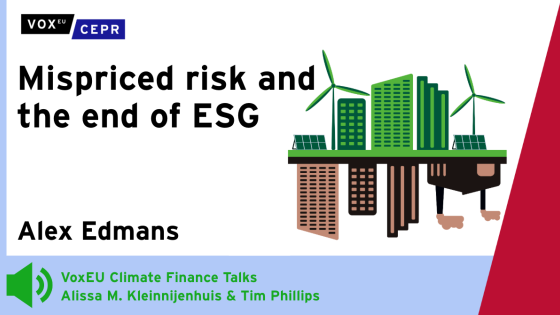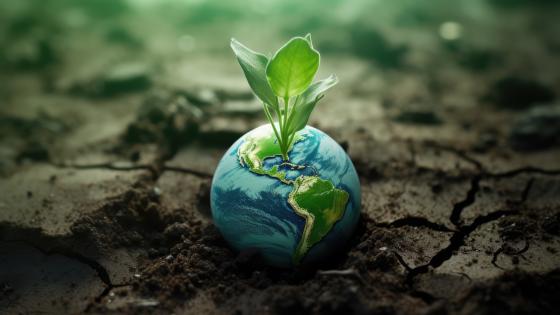Without being overly dramatic, climate change is coming. The concentration of carbon dioxide in the Earth's atmosphere is approximately 390 parts per million by volume as of 2010, and rising by about 1.9 parts per million per year (Wikipedia 2010). Recent efforts at the December 2009 Copenhagen Climate Conference and in the US Senate during the summer of 2010 have failed to overcome the fundamental free rider problem – no one individual or nation has an incentive to unilaterally reduce emissions.
Understanding how nations around the world will cope with climate change will become a major economics research topic. Up until now, adaptation research has mainly focused on the agricultural sector (Deschênes and Greenstone 2007, Schlenker et al. 2005).
In my new book, Climatopolis: How Our Cities will Thrive in Our Hotter Future (Basic Books 2010), I study how urbanites around the world will cope and adapt as climate change unfolds. The UN predicts that by the year 2030 over 60% of the world’s population will live in cities. While I do not have a crystal ball for predicting exactly how hot Moscow will be in 2012 or how much rainfall Los Angeles will receive in 2030, the basic tools of microeconomics prove to be quite useful for understanding and predicting how diverse households, firms, and governments will respond to the scary and uncertain challenges posed by climate change.
Due to differences in geography, historical circumstances, and national institutions, different cities will face different challenges. At the same time, there are some basic commonalities across cities with regards to common adaptation challenges. Basic incentive theory offers many insights into adaptation will unfold and the role that capitalism will play in facilitating adaptation.
My book stresses a fundamental irony. Urban economic growth has caused climate change (think of the billions of people who are achieving the “American Dream”) but it will also help us to adapt to climate change. My optimism about urbanites’ ability to continue to thrive in the face of climate change is based on our ability to migrate and innovate. Free markets play a central role here in determining new investment patterns that will help us to adapt.
Migration
The US has over 300 major cities. The compensating differentials literature has used hedonic techniques to document that in an open system of cities, real estate prices will adjust to reflect the value of underlying bundles of non-market attributes such as climate, air pollution, and proximity to the coast (Rosen 2002). Based on revealed preference logic, cities that continue to attract migrants and pay relatively low wages and have high rents must have high quality of life (Albouy 2009).
Climate change will shake up these rankings as some cities experience relatively more heat waves, coastal flooding risk, and reduced rainfall than others. Climate scientists will continue to make progress modelling how different geographical areas will be affected by climate change. Their “new news” will quickly be incorporated into households’ and firms’ information about the trade-offs of investing in different cities. Such climate models provide an “early warning” system and we know from countless studies that economic agents respond to “new news”. In this age of Twitter and the internet, it is unlikely that such households will not be informed about changes in quality of life in different cities.
Given that migration is a costly investment, households and firms will factor in this evolving information into their locational choices.
- If a city that today is objectively a great place to live such as San Diego suffers extremely from climate change then it will suffer an out-migration.
Labour economists have documented how population migration flows are affected by shocks to local labour demand (Blanchard and Katz 1992). While these shocks tend to be transitory, the empirical evidence highlights how mobile households respond to “new news”.
In the case of climate change, increased risk to a specific city such as San Diego is likely to be a permanent shock. The owners of land in such cities will suffer an income loss but mobile urbanites can protect themselves by moving to another city. This optimistic logic hinges on the assumption that climate change’s impacts on different cities are not perfectly correlated.
- A city such as Detroit could enjoy an amenity improvements (warmer winter) at the same time that Phoenix is suffering.
If more of the US population seeks to move to more northern cities such as Seattle then these cities will face increased demand. The recent housing supply literature has highlighted that housing supply regulation and topography determine housing supply (Saiz 2010). In those increasingly desirable cities where housing supply is inelastic, land owners will gain because of climate change induced migration. Within the EU, similar dynamics are likely to play out. Of course, this claim merits further empirical investigation.
My optimism about the role that migration can play in protecting the populace hinges on the assumption that climate change will be gradual. Cities are long-lived durable capital and it takes “time to build” the infrastructure necessary for a city ranging from housing, commercial buildings, transportation infrastructure, sewer systems, electricity generation. We can’t move whole cities over night.
- If New Yorkers were to wake up tomorrow to find out that the sea level has increased five feet, they would face few adjustment possibilities.
But the past track record suggests that this scenario is highly unlikely. If climate change does pose such abrupt “non-linearities” and we know that we “do not know” how probable such a scenario this is, then the most risk-averse of us will seek out higher ground now rather than taking a gamble.
Endogenous innovation
When gasoline prices go up, the vehicle fleet becomes more energy efficient. When energy prices go up, firms invest more money in R&D to enhance their energy efficiency. Time series research indicates that higher electricity prices are associated with subsequent introduction of more energy efficient appliances (Jaffe et al. 2003). This empirical literature on induced innovation highlights how climate change will result in new products that will help us to adapt. For example, if climate change exacerbates drought conditions in the US’ Southwest then water prices will rise. Households will seek more water efficient appliances and the market will have an incentive to supply them. In this sense, climate change will create new market opportunities.
The billions of people who will be affected by climate change create a large market opportunity for entrepreneurs who can serve this market. Acemoglu and Linn (2004) demonstrated that the extent of the market for new drugs triggers endogenous innovation. In the presence of fixed costs to developing new products, the scale of the market is a key determinant. Their logic holds in the case of climate change. If billions of people seek an energy efficient air conditioner to offset hot summers, then there will be sharp incentives to invest in developing such products. Some of these producers will succeed and in a globalised world market, the pay-off to the successful entrepreneur will be huge.
The anticipation that cities will be at risk from climate change encourages innovation. My UCLA colleague Thom Mayne is working with Brad Pitt in New Orleans to design floatable homes that could be sold for less than $200,000. These homes are intended to allow residents to literally float in the midst of the next Hurricane Katrina. Such innovative new products are just the tip of the iceberg. Climate change will create numerous such opportunities for entrepreneurs.
The impact of climate change on cities in the developing world
Cities in the developing world will face additional challenges in coping with climate change. Over the next 100 years, the major growth in urbanisation will take place in the developing world. Climate change is likely to accelerate this urbanisation as many farmers find that the profitability of continuing to farm has declined due to changes in climate. As these new urbanites move to cities, local wages will decline and local rents will increase. These general equilibrium effects mean that incumbent urban poor will suffer from such urban migration. The local urban politicians are unlikely to have strong incentives to scale up the infrastructure to provide for the new migrants. Those cities that offer rural migrants a high quality of life are likely to attract even more of such migrants. A type of tragedy of the commons will emerge.
In my own past research, I have documented that richer nations suffer fewer deaths from similar natural disasters (Kahn 2005). If climate change increases the frequency and intensity of floods and hurricanes, then poor nations will suffer more deaths from these disasters. Economic development is likely to play a causal role in shielding the population from such risks by providing households and governments with the resources to build higher quality infrastructure, to enforce zoning laws and to provide better ex-post medical care.
In this sense, economic development offers the best strategy for poor cities to cope. A salient example of the role of economic development in protecting the population from public health threats exacerbated by climate change is offered by Thomas Schelling (1997). He contrasts malaria rates in Singapore and Malaysia. Singapore, the richer “geographical twin”, has a much lower malaria rate than Malaysia.
Lessons from the Moscow heat wave of August 2010
Recently, The Economist published a generally favourable review of Climatopolis but pointed out that I had ranked Moscow as likely to be a climate change resilient city (Economist 2010). In my short list of “resilient cities”, I had focused on cities unlikely to suffer from major sea level rise that are located at northern latitudes. Martin Weitzman’s work on climate change catastrophe and “fat tails” heavily weighted on my thinking and thus my rankings. The Economist was quick to point out that even “safe cities” can and will suffer due to climate shocks caused by climate change.
A major theme of Climatopolis is that as climate scientists continue to make progress with modelling climate change and as we individually learn about the day-to-day challenges climate change poses for different cities, their residents will take pro-active steps to adapt to changing circumstances. Yes, the Moscow heat wave was deadly but the “silver lining” of this shock is that the city learned that it is at risk and I predict that it will make costly investments now to lower the impact of the next heat wave. This basic logic is why I am optimistic about our urban future. We have the right incentives to learn and to adapt to our changing environmental conditions.
References
Acemoglu, Daron and Joshua Linn (2004), "Market Size in Innovation: Theory and Evidence from the Pharmaceutical Industry", The Quarterly Journal of Economics, 119(3):1049-1090, August.
Albouy, David (2009), “Are Big Cities Really Bad Places to Live? Improving Quality-of-life Estimates across Cities”, NBER Working Paper 14472.
Blanchard, Olivier J and Lawrence F Katz (1992), “Regional Evolutions”. BPEA 1: 1–61.
Deschênes, Olivier and Michael Greenstone (2007), “The Economic Impacts of Climate Change: Evidence from Agricultural Output and Random Fluctuations in Weather “, The American Economic Review, 97(1):354-385(32)
The Economist (2010), "The ways of a warmer world”, 2 September.
Kahn, Matthew E (2005), "The Death Toll from Natural Disasters: The Role of Income, Geography, and Institutions", The Review of Economics and Statistics, 87(2):271-284,
Kahn, Matthew (2010), Climatopolis: How Our Cities will Thrive in Our Hotter Future, Basic Books.
W Schlenker, WM Hanemann, AC Fisher (2005), “Will US agriculture really benefit from global warming? Accounting for irrigation in the hedonic approach”, American Economic Review.
Jaffe A, RG Newell, RN Stavins (2003), “Technological change and the environment”, in K Mahler and J Vincent (eds.), Handbook of Environmental Economics, 1:461–516, Elsevier.
Rosen, Sherwin (2002), “Markets and Diversity”, American Economic Review, 92(1):1-15, March.
Saiz, Albert (forthcoming), “On the Local Housing Supply Elasticity”, Quarterly Journal of Economics.
Schelling, Thomas (1997), “The cost of combating global warming: facing the tradeoffs”, Foreign Affairs.
Wikipedia (2010), Carbon dioxide in Earth's atmosphere



